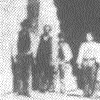 JPG photo of 1880 house, 87 kB
JPG photo of 1880 house, 87 kB
updated 13 November 1995
Ballads tell a story. "A story describes a sequence of actions and experiences of a certain number of characters, whether real or imaginary. These characters are represented in situations which change or to the changes of which they react. These changes, in turn, reveal hidden aspects of the situation and the characters, giving rise to a new predicament which calls for thought or action or both. The response to this predicament brings the story to its conclusion" (Ricoeur 1981:277). Since narrative is so essential to ballads, it deserves careful attention, since "narrative is one of the most widespread and powerful forms of speech in human communication" (Bruner 1992:81).
Narratives are the best means to express and communicate one's perception of oneself, others, and external reality. Recalling Wittgenstein's vocabulary, Ricoeur suggests that, "if narrating is a unique 'language-game,' and if a language game 'is part of an activity or a form of life,' then we must ask to which form of life narrative discourse as a whole is bound" (Ricoeur 1981: 274). Ricoeur says that any narrative is endowed with an episodic dimension, the dimension of time, which is expressed in the succession of events; and a non-chronological dimension, which constructs "meaningful totalities out of scattered events." An essential aspect, "the art of narrating, as well as the corresponding art of following a story, ... require that we are able to extract a configuration from a succession" (ibid:278).
Narrative may be considered as the outcome of an act of interpretation which gives meaning to a sequence of actions. In ballads, narrative is essential and emphasizes above all a skeleton of events which are connected and describe patterns of behavior related to events. These patterns help the narrator and audience to perceive reality by describing what a certain type of man or woman would do in certain situations. Female ballad singers emphasize the value of patterns assigned to ballad narratives by taking a detached view, denying emotional involvement through verbal choices and singing style. This impersonal performance style seems related to the impersonality of ballad narratives. They are not dependent on ordinary chronicles or anecdotes as in Italian broadside ballads, for example.
Narrative ballads are emblematic rather than historical. But
fictional narratives assist us to be "in history" and emphasize
our need to cope imaginatively with reality. "By its mimetic
intention, the world of fiction leads us to the heart of the real
world of action" (Ricoeur:298).
Topics of Italian ballads
One can examine the topics of the Italian ballads, referring to
the comprehensive and celebrated Nigra's collection, which
includes most ballads actually sung in the nineteenth and twentieth
centuries. Unlike North-European ballads, the Italian
repertoire has no magic elements (1), or episodes from
epic literature. Nigra has only a few stories about men
and most of those men are social undesirables: a deserter,
no. 27; card-players, no. 22; violent students, no. 5;
prisoners, no. 47, for example.
Most ballads widespread in Northern Italy cited in Nigra were stories of women and usually about the relationship between women and men.
Topics can be categorized into five main groups.
Narrative ballads deal with other topics, but these are the main ones.
All in all, ballads are mainly concerned with stories of women and in
particular with the representation of the dangers coming from men
(abduction, rape, murder, betrayal, mistreatment, abandonment), with the terrible
consequences coming from a conflict with family or authority for
questions of love (imprisonment, death) or from breaking the law,
and virtuous female behavior.
Narrative characteristics
Italian balladry has four basic narrative features (Bruner:81-82):
Italian ballads as a whole represent a sort of comprehensive survey of the possible events originating in a relation and connected models of behavior. From this point of view, ballads manifest different functions. They reveal a prominent educational value, by showing model behavior for honest women and the dangers coming from breaking morals or the law. Actually, the values manifested in ballads, especially the importance of honor and the condemnation of transgression, were shared by the whole society. Moreover, ballads had another function: singing ballads was an occasion for women to develop imaginative activity, which has an extremely important role at the psychological level. Finally, singing and creating ballads meant to work out a representation of the world and life, or better, of those aspects of the world and life that women knew better and in which they were more interested. We cannot omit considering that women in the countryside lived essentially within the boundaries of the household and farm and had limited contacts with the external world, while men travelled, made war, dealt with the landowner and authorities, frequented taverns. In this situation, women's creative imagination focused necessarily on the cases of life that they could experience and imagine and on the problem of the relation with men, which had a paramount importance in women's life, since it determined its course. While recognizing the fundamental dependence of women's fate on the relation with men, ballads helped to maintain this condition, by transmitting this worldview. But this and the other functions of the ballad, strictly connected to women's way of life in the nineteenth and early twentieth century, was bound to disappear.
 JPG photo of 1880 house, 87 kB
JPG photo of 1880 house, 87 kB